 | ||
The Opaline budgerigar mutation is one of approximately 30 mutations affecting the colour or appearance of budgerigars. It is the underlying mutation of the Opaline variety. When combined with the Yellowface II and Clearwing mutations the Rainbow variety is produced.
Contents
Appearance
The Opaline mutation is characterised by several features which are invariably present, although many show variations in the intensity of their expression. The most obvious effect is on the striations which extend from the top of the head down the neck to between the wings in the non-Opaline. In the Opaline these striations are very much reduced in intensity, being almost absent in many individuals, particularly in small birds of yellow (as opposed to buff) feather. The cap of the Opaline extends further back over the top of the head, gradually merging into an area the same colour as the body which continues down the back of the head to form a 'V' shape between the wings. The intensity of the striations in this area is variable, but in the original mutations, particularly the Australian, the 'V' was very clear.
In the non-Opaline the wings show dark grey or black markings over a yellow or white ground, but in the Opaline the ends of the barbs of the wing coverts assume the same colour as the body, rather than the ground colour. This suffusion of body colour in the wings produces the opalescent effect which gave the mutation its name. The area of black pigmentation in each feather is reduced and in the original specimens the wing butts were particularly devoid of black pigment, resulting in a clear area often called the 'thumb-print'. These thumb-prints appear to be associated with a clear 'V', but are now seen less often, since the Budgerigar Standard calls for normal wing markings in the Opaline.
The flight feathers of the budgerigar consist of 10 primaries and 10 secondaries. These are dark grey with a clear central band across every feather from the 2nd primary to the 8th secondary. These clear areas are not visible in the folded wing, but form a prominent continuous band running right along the wing when it is stretched out. It is hidden from above by the coverts but is visible from beneath. In the Opaline this clear band is present on every flight feather and is much broader. Only the distal half of the flight feather is dark, with the clear zone extending from the midpoint to the shaft. Because it is broader it is visible in the primaries of the folded wing of the Opaline, just beneath the secondaries and primary wing coverts, as a small clear patch.
A similar effect occurs in all the wing feathers, most noticeably in the primary and secondary wing coverts, and also in the six tail feathers, which carry a similar clear band on feathers 2 to 6 in the non-Opaline. The first (longest) tail feather of the Opaline also carries a rather blotchy clear area of somewhat variable extent, and the suffusion of body colour present to a small degree in the non-Opaline is intensified in the Opaline.
Most Opalines show a brighter body colour than the corresponding non-Opaline, particularly in nest feather and particularly in the rump area. This is due to a reduction in the melanin content of the barbules of the contour feathers.
The final characteristic of the Opaline (and the Cinnamon) is the colour of the down feathers of the young nestling. These are white instead of the usual grey, and this allows Opalines to be identified at a very early age.
Genetics
The Opaline mutation is sex-linked, the locus of its gene being carried on the X chromosome. It is recessive to wild-type. The gene locus has the symbol op. The wild-type allele at this locus is notated op+ and the Opaline allele is notated op.
In birds, the cock has two X chromosomes and the hen has one X and one Y chromosome. So in hens whichever allele is present on the single X chromosome is fully expressed in the phenotype. Hens cannot be split for Opaline (or any other sex-linked mutation). In cocks, because Opaline is recessive, the Opaline allele must be present on both X chromosomes (homozygous) to be expressed in the phenotype. Cocks which are heterozygous for Opaline are identical to the corresponding Normal. Such birds are said to be split for Opaline, usually written '/opaline'.
The table on the right shows the appearance of all possible genetic combinations involving the Opaline mutation.
The Opaline gene is linked to other genes located on the X chromosome, i.e. to the genes of other sex-linked mutations. These sex-linked mutations include the Cinnamon and Slate mutations and the two allelic mutations at the ino locus—the Ino and the Sex-linked Clearbody. The cross-over or recombination values between Opaline and these linked genes has not been measured accurately, but results collected by C Warner and T Daniels found 41 crossovers in 113 between Cinnamon and Opaline, giving a recombination ratio of 36±6%. Since the ino locus is known to be very close to the cin locus, the recombination ratio between Opaline and both Ino and Sex-linked Clearbody must also be around 36%. The opinion has been expressed that there is a close link between Opaline and Slate.
Cocks split for both Cinnamon and Opaline have one Cinnamon allele and one Opaline allele together with one each of the corresponding wild-type alleles. The linkage between the Cinnamon and Opaline genes gives rise to two types of split cinnamon-opaline cocks, both visually identical.
Hens cannot be split for any sex-linked gene, so only cocks exist in Type I and Type II form.
